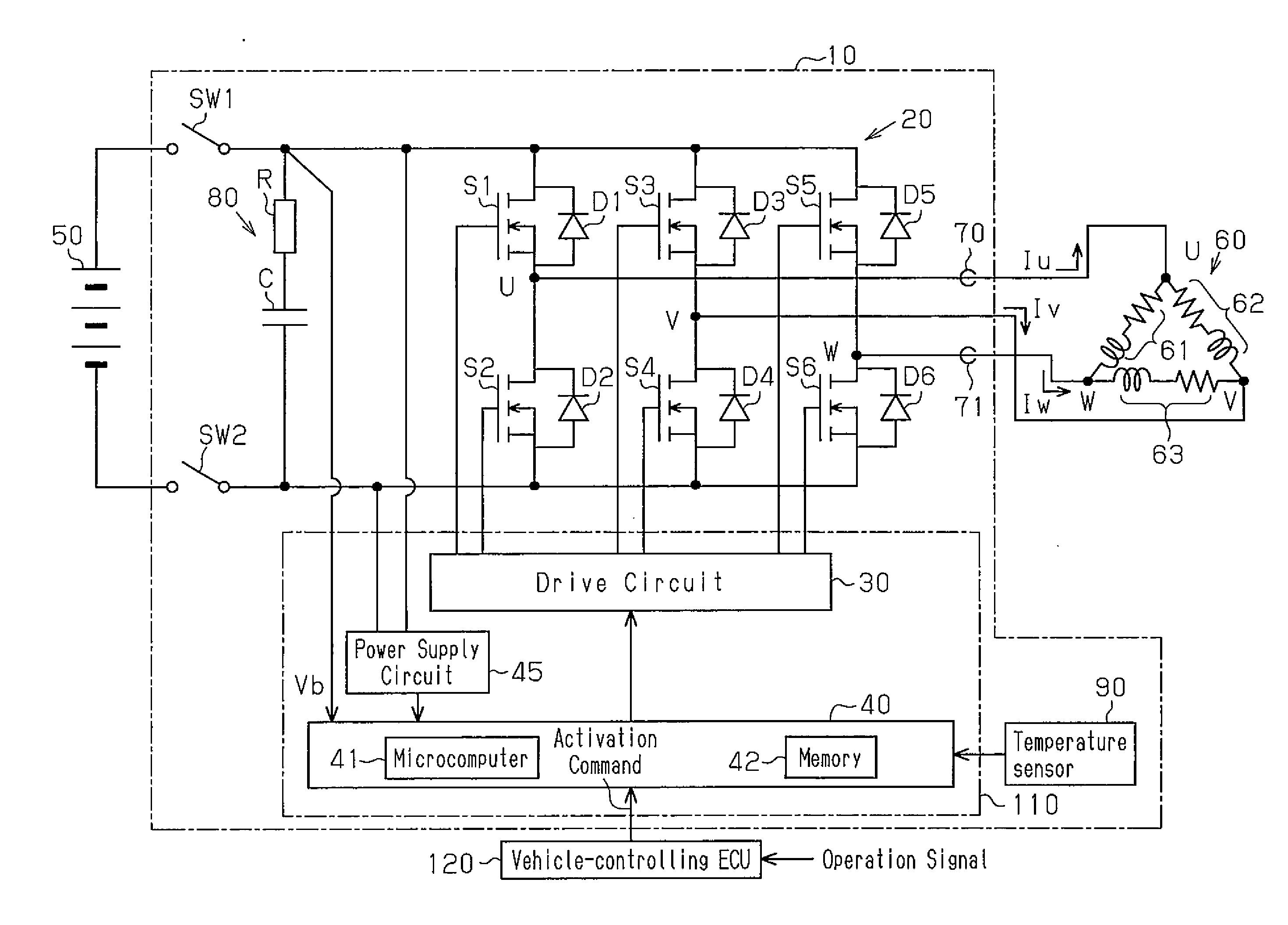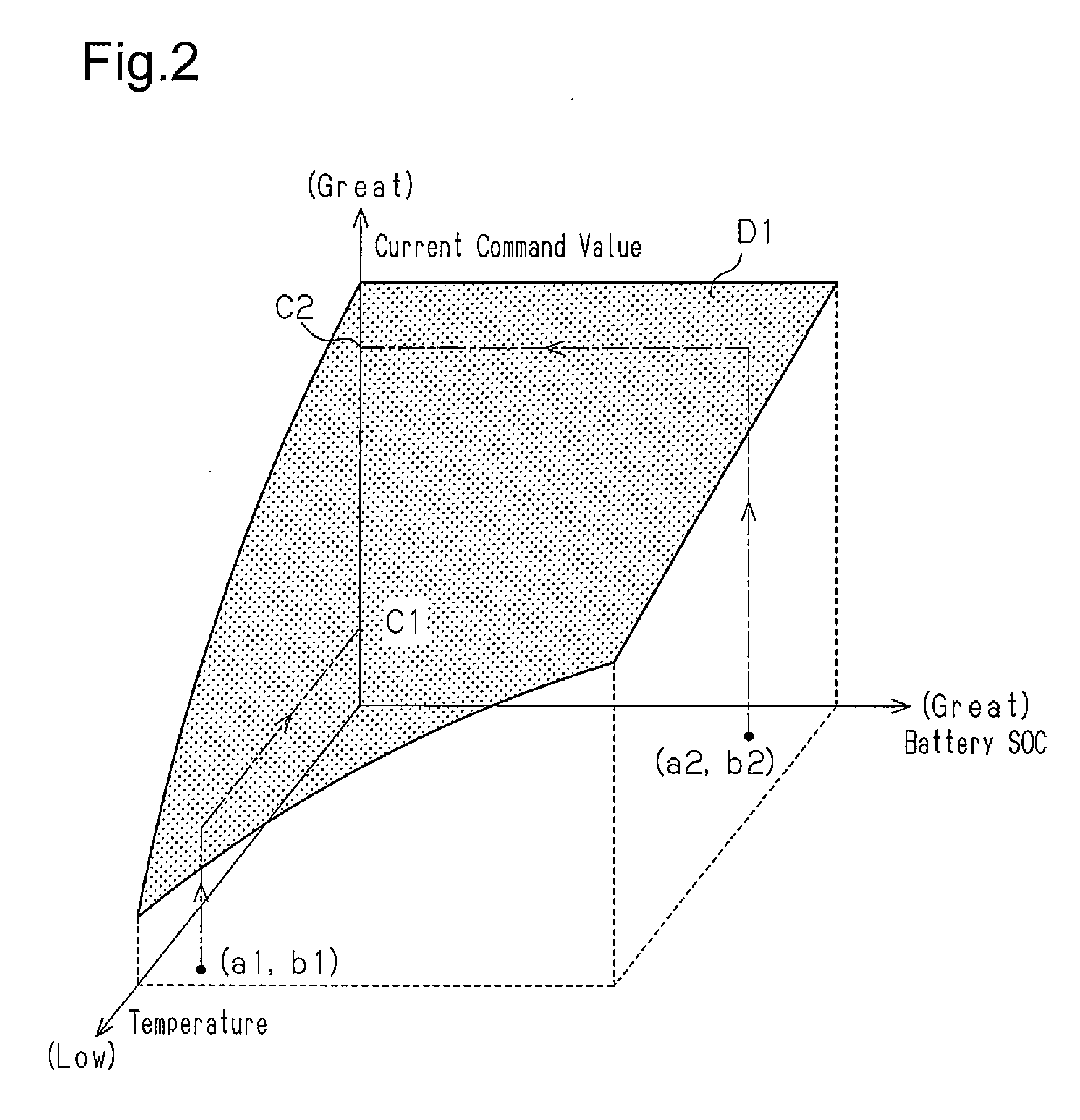Inverter device
a technology of inverter and capacitor, which is applied in the direction of capacitor propulsion, battery/fuel cell control arrangement, instruments, etc., can solve the problems of long time-consuming and laborious, and limited current value of warm-up control of capacitors, etc., and achieve internal resistance increase, internal resistance increase of battery, and undesirable increase of voltage drop amoun
- Summary
- Abstract
- Description
- Claims
- Application Information
AI Technical Summary
Benefits of technology
Problems solved by technology
Method used
Image
Examples
first embodiment
[0018]An inverter device according to one embodiment of the present invention will now be described with reference to the drawings. The inverter device is mounted on a forklift and activates a driving electric motor and a cargo handling electric motor of the forklift. The forklift is a battery-operated forklift. The forklift is driven by a vehicle driving electric motor and performs cargo handling with a cargo handling electric motor. That is, when an operator operates an accelerator pedal in a state in which the key is turned on, the driving electric motor is activated to drive the forklift forward or rearward. When the operator manipulates the lift lever, the cargo handling electric motor is activated to lift or lower the fork to handle a cargo. Such a forklift may be used in a cold storage in which the ambient temperature is less than or equal to −40° C.
[0019]As shown in FIG. 1, an inverter device (three-phase inverter) 10 includes an inverter circuit 20, a drive circuit 30, and ...
second embodiment
[0052]A second embodiment will now be described. The differences from the first embodiment will be mainly discussed.
[0053]In general, the internal resistance of the capacitor and the battery is increased at low temperatures. Thus, during the warm-up control, the current command value for performing the warm-up control is determined such that the dropped voltage does not fall below a certain value factoring in the battery state of charge and the system temperature.
[0054]In the first embodiment, since the current command map shown in FIG. 2 is prepared in advance, the battery (rechargeable battery) is assumed to be the one that has the greatest internal resistance and the degree of deterioration among the various types. Thus, if the internal resistance of the battery (rechargeable battery) is small, the current value is reduced although the battery has a current supplying capability. From the perspective of users, the warm-up control is preferably promptly completed for full-power ope...
third embodiment
[0063]A third embodiment will now be described. The differences from the second embodiment will be mainly discussed.
[0064]The second embodiment includes the learning function in which the current command value corresponding to the temperature and the battery SOC in the current command map is updated based on the battery voltage during the warm-up control. The current command value when performing the warm-up control is determined based on the previously learned result. At this time, if the warm-up control is not frequently performed, that is, if the time period from when the previous warm-up control is performed to when the present warm-up control is performed is long, deterioration of the battery may have progressed. In this case, depending on the current command value, the voltage drop amount may be greater than expected and may undesirably fall below the minimum voltage required for system operation.
[0065]The present embodiment determines the optimal warm-up control current comma...
PUM
 Login to View More
Login to View More Abstract
Description
Claims
Application Information
 Login to View More
Login to View More - R&D
- Intellectual Property
- Life Sciences
- Materials
- Tech Scout
- Unparalleled Data Quality
- Higher Quality Content
- 60% Fewer Hallucinations
Browse by: Latest US Patents, China's latest patents, Technical Efficacy Thesaurus, Application Domain, Technology Topic, Popular Technical Reports.
© 2025 PatSnap. All rights reserved.Legal|Privacy policy|Modern Slavery Act Transparency Statement|Sitemap|About US| Contact US: help@patsnap.com



